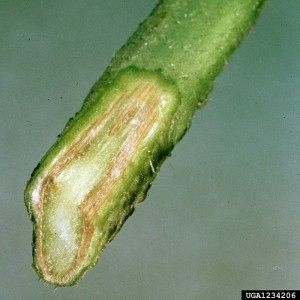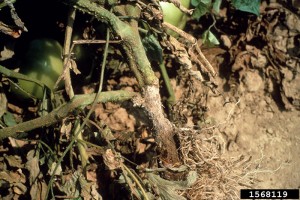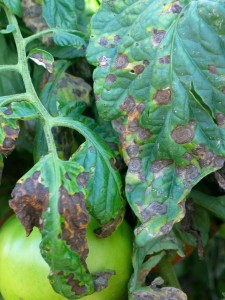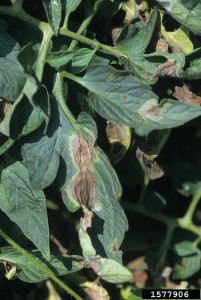Common Diseases of Tomatoes: Part I. Diseases Caused by Fungi
Diseases are a major limiting factor for tomato production. Diseases can be classified into two groups. The first are those caused by infectious microorganisms that include fungi, bacteria, viruses and nematodes. These diseases are contagious and can spread from plant to plant in a field, often very rapidly when environmental conditions are favorable. The second group includes those caused by non-infectious physical or chemical factors, such as adverse environmental factors, nutritional or physiological disorders and herbicide injury. Non-infectious diseases cannot spread from plant to plant; however, the distribution of the disease may be quite uniform and extensive if an entire planting was exposed to the adverse factor.
It is critical for effective disease control to recognize the difference between infectious and non-infectious diseases, and the type of microorganism causing an infectious disease be determined. For example, use of a fungicide to control a non-infectious disease, such as blossom-end rot, is a wasted expense that will not correct the problem. This Fact Sheet is intended to aid vegetable producers in recognizing the symptoms of common tomato diseases caused by fungi. Fungi are the most common cause of infectious plant diseases and can be very destructive. Diseases of tomatoes caused by bacteria, viruses, and nematodes are described in Extension Fact Sheet EPP-7626. Non-infectious diseases of tomato are covered in Extension Fact Sheet EPP-7627. Often, symptoms of diseases are non-typical or confusing. It is a good practice to submit samples of diseased plants to the OSU Plant Disease and Insect Diagnostic Laboratory for an accurate diagnosis, particularly when a new disease is encountered.
Control of tomato diseases is best if all available methods (i.e. cultural practices, disease resistant varieties, and use of chemicals) are integrated into an overall management strategy. Cultural practices are aimed at avoiding disease or delaying its occurrence. It is critical to start with disease-free transplants because many infectious diseases may be carried on tomato seed. Crop rotation is another cultural practice for reducing losses from plant diseases. It is important to remember that vegetables such as pepper, eggplant and potato should be avoided in rotations with tomatoes. These crops are susceptible to many of the same diseases. Cultural management of the crop will also influence what diseases may develop. Tomatoes allowed to spread on the ground will develop more soil rot problems, while fruit on staked or trellised plants will be exposed more to sunscald. Tomatoes irrigated by sprinkler systems that wet the foliage and fruit are more likely to develop disease problems than those watered by drip or furrow systems.
Planting disease-resistant varieties is probably the most effective and economical method of disease control. Disease resistance can be utilized to solve current problems or to prevent a disease from increasing. Fortunately, many excellent tomato varieties have been developed with resistance to one or more of the common tomato diseases. The letters “V” (Verticillium wilt), “F” (Fusarium wilt), “N” (root-knot nematode), “T” or “TMV” (tobacco mosaic virus), “A” or “ASC” (Alternaria stem canker) and “S” or “St” (Stemphyllium-gray leaf spot) appear in the variety descriptions in seed catalogs or on seed packages to designate resistance to the corresponding diseases. Strains of the Fusarium wilt fungus have developed that can overcome previously resistant varieties. “F1” indicates resistance to the original strain (race 1), while “F2 and F3” indicate resistance to new strains (races 2 and 3). Extension Fact Sheet HLA-6032 lists many disease-resistant tomato varieties known to perform well in Oklahoma.
Chemical control is sometimes necessary because resistance is not yet available for some important diseases. The registration status, rates, timings and method of application of fungicides often change. Consult the current Extension Agents Handbook of Insect, Plant Disease and Weed Control (E-832) or the local county Extension educator for the latest recommendations for chemical control of tomato diseases.
Wilts & Blights
Fusarium Wilt
(Fusarium oxysporum f.sp. lycopersici)
Wilt diseases are caused by pathogens that invade the vascular system (xylem tissue) and disrupt water flow through the plant. Fusarium wilt is the major wilt disease of tomato in Oklahoma. Verticillium wilt is easily confused with Fusarium wilt, but has not yet been reported in Oklahoma.
The first symptom is usually a yellowing of the lower leaves, which gradually wilt and die. Symptoms may first occur on only one side of the plant (Figure 1). The disease progresses up the stem until all of the foliage is killed and the plant dies. If stems or petioles from wilted areas of diseased plants are cut, a reddish-brown discoloration can be seen between the pith (center of the stem) and the outer green part of the stem (Figure 2).
The fungus survives and persists indefinitely in field soil. The fungus is also seedborne and is thought to spread long distances in this manner. The disease is most serious in sandy soils and at temperatures between 80 F to 90 F. Soils become infested by planting infected transplants and from movement of infested soil by wind and water erosion or on farm implements.
Control: Growing tomato varieties resistant to Fusarium wilt is the most effective means of
control. Improved varieties and hybrids are available that have resistance to races
1 and 2; and 1,2 and 3. Resistant varieties can become susceptible to
Fusarium wilt through time when they are intensively cropped on the same site. For
example race 3 has been reported in other states where tomatoes are intensively grown.
Crop rotation should be used in conjunction with varietal resistance to maintain sustainable
control and limit the development of new races.

Figure 1. Fusarium wilt—Initial symptoms are yellowing and wilting of branches and later, entire plants (photo courtesy R.G. Gardner, North Carolina State University).

Figure 2. Fusarium wilt—Internal discoloration of stem. (Photo courtesy Clemson University, USDA Cooperative Slide Series, Bugwood.org)
Southern Blight
(Sclerotium rolfsii)
Southern blight can be a devastating disease of tomatoes in Oklahoma. The southern blight fungus has a wide host range attacking more than 200 species of plants that include common weeds and crop plants.
The initial symptom of southern blight is a rapid wilting of the entire plant. A water-soaked lesion on the stem near the soil line rapidly expands, turns brown and girdles the stem. A white mold (mycelium) eventually covers the stem lesion and surrounding moist soil. Small, uniformly round structures about 1/16 inch in diameter (called sclerotia) form on the mycelium. Sclerotia are first white, later becoming brown, and resemble mustard seeds. The presence of the white mycelium and sclerotia at stem base of affected plants are very useful characteristics for identifying southern blight (Figure 3).
The fungus survives in the soil as sclerotia, which may build to high numbers when susceptible plants are cropped repeatedly. After sclerotia germinate, the fungus must first colonize organic debris near the soil surface before the fungus can cause infection. The disease is favored by high humidity and soil moisture and warm to hot temperatures (85 F to 95 F).
Control: Southern blight is difficult to control when conditions favor the disease and numbers of sclerotia in the soil are high. Crop rotation with a non-susceptible grass crop, such as corn, is the most effective means of reducing numbers of sclerotia and resulting incidence of southern blight. Avoid planting tomato following a very susceptible crop such as cantaloupe or watermelon. Plant residues should be thoroughly incorporated into the soil prior to transplanting so their presence on the soil surface does not encourage southern blight development. A fungicide program for southern blight may be beneficial.

Figure 3. Southern blight—White moldy growth (mycelium) and basal stem canker. (Photo courtesy Ed Sikora, Auburn University, Bugwood.org)
Foliar Diseases
Early Blight
(Alternaria solani)
Early blight is a common leaf-spotting fungal disease of tomato. Extensive defoliation
from early blight exposes fruit to sunscald and increases fruit rot. Early blight
also attacks stems and fruit. Foliar diseases are most severe in eastern Oklahoma
where rainfall and relative humidity levels support disease development, or wherever
sprinkler irrigation is used.
Dark brown cankers may develop on stems and girdle stems of seedlings at the soil line. Stem lesions on older plants usually remain confined to one side of the stem. Leaf symptoms appear on older leaves first and are characteristic of the disease. Infected leaves show circular spots (lesions) up to 1/2 inch in diameter that are brown and have a pattern of concentric rings imparting a “target-like” appearance to the spot (Figure 4). The leaf area surrounding these spots may turn yellow. Infected leaves eventually turn brown and drop from the plant. Defoliation progresses upward from the lower plant. Sunken, dry lesions occur most frequently on the stem end of the fruit and also have a zonate or “target-like” appearance.
The fungus survives in the soil by forming resistant spores in association with diseased tomato debris capable of persisting for one year or more. Infection occurs rapidly under warm, humid conditions. Thousands of spores are produced in spots of infected leaves and are capable of causing more infections. Plants under stress from nitrogen deficiency, heavy fruit load or other factors are most susceptible to the disease.
Control: Crop rotation with crops other than eggplant, potato and pepper should be practiced to reduce and delay early blight development. Avoid prolonged wetting of leaves from irrigation or use drip irrigation. Maintain adequate, but not excessive, soil fertility. A spray program using a recommended fungicide beginning at fruit set and continuing on a 7- to 14-day schedule should be maintained where early blight problems are anticipated.

Figure 4. Early blight—Leaf symptoms are large (up to 1/2 inch diameter), brown, zonate or target-like spots.(Photo courtesy M. McGrath, Cornell University)
Septoria Leaf Spot
(Septoria lycopersici)
Septoria is a very common foliage disease in Oklahoma that may also attack stems, but not fruit. The disease first appears on the lower leaves after the plant has set fruit. Leaf spots begin as yellow areas that later become circular with gray centers and dark borders (Figure 5). Spots may reach 1/8 inch in diameter and be surrounded by a yellow halo. Tiny black specks may develop in the center of these spots. These are fruiting structures that release spores. Severely infected leaves fall off. Defoliation progresses from the base of the plant upwards and resembles early blight from a distance. However, the larger dark leaf spots with concentric rings of early blight are clearly different from smaller Septoria leaf spots. Loss of foliage may cause fruits to become sunscalded.
Most infection early in the season probably arises from infested plant debris remaining in the soil from a previous tomato crop. Spores of the fungus are spread by splashing rain. The disease is favored by moderate temperatures and extended periods of high relative humidity.
Control: Crop rotation and thorough shredding and incorporation of infested plant residue soon
after harvest are recommended to reduce Septoria leaf spot. Weed control should be
maintained because jimsonweed, horse nettle and nightshade are also sources of infection.
Drip is recommended to reduce periods of leaf wetness and water splashing. Sprinkler
irrigation should not be used. Avoid working plants while foliage is wet. A fungicide
spray program for early blight will also be effective for control of Septoria leaf
spot.

Figure 5. Septoria leaf spot—Leaf symptoms are small (1/8-inch diameter) spots with gray centers and dark borders.
Gray Leaf Spot
(Stemphyllium solani)
This is a disease confined entirely to the leaves of tomato. The oldest leaves are affected first. Symptoms first appear as small brownish-black flecks that extend to both sides of the leaf. Spots may be bordered by a narrow yellow halo. As the spots enlarge, the central portion becomes gray, cracks and falls out imparting a shot-hole appearance to affected leaves. The disease closely resembles Septoria leaf spot. Leaves with numerous spots turn yellow and drop to the ground. The fungus overwinters on infected plant residue. The disease is favored by warm temperatures, high humidity, heavy fruit loads and adequate levels of soil fertility.
Control: Many of the newer tomato varieties recommended for growth in Oklahoma are resistant to gray leaf spot. If a susceptible variety is grown, cultural and chemical controls are similar to those for early blight and Septoria leaf spot.
Late Blight
(Phytophthora infestans)
Late blight, an important potato disease, can also occur on tomato. The warm to hot temperatures prevailing in Oklahoma during periods of tomato production make the occurrence of this disease unlikely. However, the disease could be a potential problem during unseasonably cool and wet conditions on early-planted or fall-cropped tomatoes. All parts of the plant are affected and fruit decay can be severe.
Symptoms appear on the upper surface of leaves as greasy, gray spots that expand rapidly when leaves are wet or humidity is high (Figure 6). White mold usually develops at the margins of affected areas. If stems and petioles are infected, areas above these infections wilt and die. Entire plants may be rapidly defoliated when conditions favor the disease. Fruit infections begin as brown, greasy spots that rapidly expand to rot the entire fruit.
The fungus is a wet weather disease favored by cool nights and warm days. Temperatures above 86 F are considered unfavorable for late blight development. The fungus survives mainly in potato seed tubers and in infected tomato transplants. Some survival may also occur in dead potato and tomato vines. The disease often begins in potato plants, from which spores of the fungus are blown by wind to infect tomatoes in favorable conditions. Disease development is rapid with extended periods of favorable conditions and ceases when weather becomes hot and dry.
Control: Late blight control centers on use of disease-free transplants and certified disease-free potato seed to avoid introduction of the disease. Tomatoes should be planted as far as possible from potatoes and potato cull piles. Dead vines from previous crops should be removed from the vicinity of new plantings or destroyed. Avoid use of sprinkler irrigation where possible. A fungicide spray program is required to control late blight.

Figure 6. Late blight—Foliage symptoms are dark blotches surrounded by pale green borders. (Photo courtesy G. Holmes, California Polytechnic State University, Bugwood.org)
Fruit Rots
Anthracnose
(Colletotrichum phomoides)
Anthracnose is a common and widespread rot of ripe or overripe tomato fruit. Symptoms
are rare on green fruit. Symptoms on ripe fruit are small, sunken, circular spots
that may increase in size up to 1/2 inch in diameter. The center of older spots later
become blackish (Figure 7). Spots may become numerous in severe cases, and secondary
rotting organisms may invade anthracnose lesions to completely rot infected fruit.
The fungus forms small, dark survival structures called sclerotia in the centers of
fruit spots. These sclerotia survive in soil for up to three years, and cause infections
either directly or by producing secondary spores. Green fruit are infected but do
not show symptoms until ripening. The fungus then spreads from infected to healthy
fruit as spores are splashed by rain or overhead irrigation, or by pickers working
wet plants. Anthracnose is favored by warm rainy weather, overhead irrigation and
heavy defoliation from foliar disease.
Control: Harvest fruit as soon as possible after ripening. Avoid excessive overhead irrigation or use drip irrigation to reduce moisture levels on fruit and humidity in the plant canopy. Fungicide sprays used to control leaf diseases reduce losses from anthracnose when applied on a regular schedule and in a manner to achieve thorough fruit coverage. A three-year rotation may also reduce chances for infection.
Soil Rots
Soil rots are caused by several fungi which reside in soil and infect fruit in direct contact with the soil or are splashed into lower fruit near the soil. Warm, wet conditions and growth of tomatoes in poorly drained areas favor soil rot development. Ripe fruit is generally most vulnerable to soil rot development, however green fruit may also be affected.
Buckeye rot
(Phytophthora nicotinae)
Buckeye rot is a destructive fruit rot of green or ripe fruit. The first symptoms are grayish-green or brownish, water-soaked spots developing where fruit contact the soil or where soil frequently splashes onto fruit. When temperatures are warm (more than 80 F) the spot rapidly enlarges to cover up to half of the fruit diameter. The rot then appears brown with concentric rings that resemble the markings of a buckeye chestnut (Figure 8). The disease is most severe in poorly drained areas.
Southern blight
(Sclerotium rolfsii)
The southern blight fungus causes a sunken, yellowish lesion to develop where ripe
fruit contact the surface of infested soil. The lesion enlarges to become star-shaped
and water-soaked. The entire fruit collapses within 3 days to 4 days. A mass of white
mold and developing sclerotia become evident on the lower side of rotted fruit.
Pythium rot
(Pythium spp.)
Pythium rot begins as a small water-soaked spot where the fruit contacts the soil.
Within 72 hours, the entire fruit becomes rotted, the skin ruptures and the watery
contents of the fruit spill out. A white, cottony growth may be observed within rotted
areas of the fruit under humid conditions.
Rhizoctonia soil rot
(Rhizoctonia solani)
Rhizoctonia causes a brown rot with alternating light- and dark-colored zonate bands
and sharply defined margins in areas where fruit contact soil. The rot may be firm
at first, but later, affected fruit becomes mushy.
Control: Tomatoes should be staked or otherwise held upright to minimize fruit contact with soil. Avoid planting tomatoes in poorly drained soils or in low areas of a field. Mulching with plastic film or with organic matter to keep fruit from contacting the soil and/or to reduce soil splashing onto fruit will reduce the chance of soil rot infection. A fungicide spray schedule for foliar disease control may also help reduce infection, provided coverage of the fruit is achieved.
References
Sherf, A.F. and MacNab, A.A. 1986. Vegetable Diseases and Their Control, 2nd Ed. John Wiley & Sons, NY, 728pp.
Jones, J.B., Jones, J.P.,Stall, R.E., and Zitter, T.A. 1991. Compendium of Tomato Diseases. APS Press, St.Paul, 73pp.
John P. Damicone
Extension Plant Pathologist
Lynn Brandenberger
Extension Horticulturist
